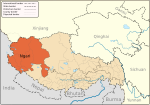Rutog Town
Rutog | |
|---|---|
 | |
| Coordinates: 33°23′6″N 79°43′48″E / 33.38500°N 79.73000°E | |
| Country | People's Republic of China |
| Province | Tibet Autonomous Region |
| Prefecture | Ngari Prefecture |
| County | Rutog County |
| Population | |
| • Total | 1,000 |
| Time zone | UTC+8 (CST) |
Rutog or Rudok (Chinese: 日土) is a town and seat of Rutog County in far western Tibet. It is the seat of Rutog County in the Ngari Prefecture. It is located 126 kilometres by road northwest of Shiquanhe (Ali/Ngari). The town has a population of about 1000 people. Older reference works give the name as Rudok.
It lies approximately 10.5 miles east of Zhabsang near Pangong Tso lake.
Rutog is a small town on the Ladakh frontier of Tibet, close to India. Rudok is picturesquely situated on the side of a hill standing isolated in the plain near the east end of Lake Pangong in Ladakh. Historically an integral part of Ladakh, it is also geographically and culturally a part of Ladakh. The houses are built in tiers, whitewashed and walled in. At the top of the hill are a large palace and several monasteries painted red. About a mile away from the foot of the hill is another monastery. Rudok is about 13,300 feet above sea-level, and the greatest altitude on the route connecting it with Lhasa at the pass of Mariom la (the water-parting between the Brahmaputra and the Sutlej) is 15,500 feet. The winter climate of Rutog and of all the towns of the Tsangpo basin, owing to the intense dryness of the air and the light fall of snow, seems to be bracing and exhilarating rather than severe. The thermometer never approaches the minimum record of Puetra (in the same latitude and at half the absolute elevation), according to the observations of native surveyors.[1]
Transportation
See also
References
- ^ One or more of the preceding sentences incorporates text from a publication now in the public domain: Chisholm, Hugh, ed. (1911). "Rudok". Encyclopædia Britannica. Vol. 23 (11th ed.). Cambridge University Press. p. 815.


